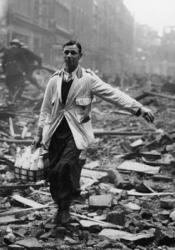The Blitz
The Blitz was an eight month long bombing campaign against the United Kingdom, especially East London, by the Germans during World War II. During this time, the Docklands in the East End of London, where the pub Limehouse is located, contained some of the city's most important hubs for imports and had storafe areas for necessities that were needed to support the war effort. Due to this, it became a huge target for bombing raids. The Germans believed that if they could cut off this major hub, that the United Kingdom would have supply shortages and the overall country would be weaker and easier to overcome. After the first night of the Blitz, there were over 1900 casualties, and by the end of it, over 47,000 houses were destroyed. They even bombed Buckingham Palace in 1940. After this period and after the war, the East End was almost completely destroyed and much of the land was in ruins, meaning that there was a lot of work that went into rebuilding the city. The men in this photo most likely would have been dockworkers who stopped by the pub after work and the woman in the photo could have been a sex worker trying to make money in a time when the world was rebuilding its wealth after the Second World War.
Oakley, Malcolm. World War 2 and East London. East London History. 7 Oct. 2013.
https://www.eastlondonhistory.co.uk/world-war-2-east-london/
Accessed 27 Mar 2022.
Britannica, The Editors of Encyclopaedia. the Blitz. Encyclopedia Britannica, 31 Aug. 2021.
https://www.britannica.com/event/the-Blitz.
Accessed 27 March 2022.
The economic downfall from the stock market crash caused the economy of the United Kingdom to do a tailspin and completely fall apart. With high unemployment rates and low demand for exports out of Europe, many people were scared of how they were going to be able to survive this time in their lives. Towards the end of the Great Depression was when World War II began. This photo by Bill Brandt takes place in the Docklands of London, on the East End. This was a hub for imports and exports for the United Kingdom and due to that, was a huge target for German bombers in the beginning of World War II. This was when the Blitz occurred for a period of about 8 months. The goal of the Germans was to weaken the country by not allowing it to get anything shipped in and for not getting anything sent out. After these bombings, London was nearly unrecognizable, and it took lots of hard work to rebuild the country back up to what it once was prior to the war. The time after World War II, when this photo of Charley Brown’s Pub was taken by Bill Brandt in 1945, was a time of growth, hope, and rebuilding. This was a time that called for all hands on deck. The men in this photo, most likely dockworkers, played a large role in rebuilding the country. They were the ones loading and unloading ships that were being sent in and out. They were the ones who were the backbone of the country who worked to make it a better place. In 1928, women in the United Kingdom were given universal suffrage. From that time up until World War II and beyond, more and more women began to be a part of the work force and become the “New Woman” that had many talents and skills. During World War II, women had to step up and take the place of many of the jobs that men had to abandon to go to war. After the war, women believed that they should keep the jobs and be able to have a place in the work force. This was an important period in time because although legally women were given equal rights in 1928 by Parliament, socially, there was still inequality between men and women. Women’s work towards the war effort showed men that they were capable and that they were deserving of their rights. Additionally, after World War II when many countries had to be rebuilt both physically and economically, the more help, the better. Therefore, I believe speaking about the newfound independence and freedom of women during this time is important to note when looking at this image. The men in this photo most likely would have been dockworkers who stopped by the pub after work and the woman in the photo could have been a sex worker trying to make money in a time when the world was rebuilding its wealth after the Second World War. However, I think that there is an argument that the woman in the photo is in fact not a sex worker and is a woman coming home from work. She may represent the modern woman at this time by wearing pants and a long coat, having short hair, and being in the Docklands of London, right where all of the docks were that were being loaded and unloaded. I believe that all three of these events: The Slump, the Blitz, and women entering the work force all had a great influence on this image.

